Text and photos (except where noted) by Jana Bryan Wunderle, JMMDS
Julie and I recently enjoyed a fieldtrip to Wentworth, NH, to visit the Shin-Boku Nursery on the western edge of the White Mountains. We were conducting research for a private garden we are designing for a client whose first love is trees, and this specialty plant nursery is renowned as very likely the largest nursery in North America dedicated to the production of Japanese garden trees, grown in and suitable to New Hampshire’s rugged climate.
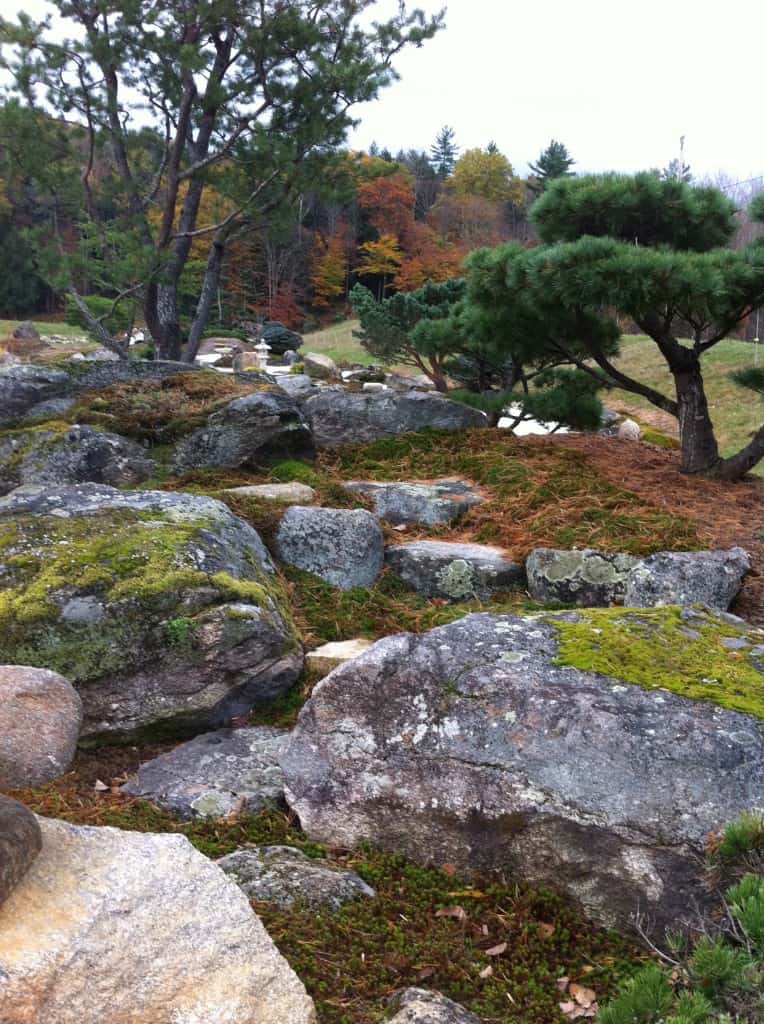
The Stroll Garden at Shin-Boku Nursery in Wentworth, NH.
Shin-Boku’s owner, Palmer Koelb, was delivering coffee to his foreman when we arrived, so we had a few minutes to experience his stroll garden on our own. Small stepping stones, moss-covered boulders, and sculptural trees are designed to create a journey that adds up to much more than the distance traveled. It was a wonderful first impression and introduction to Shin-Boku.
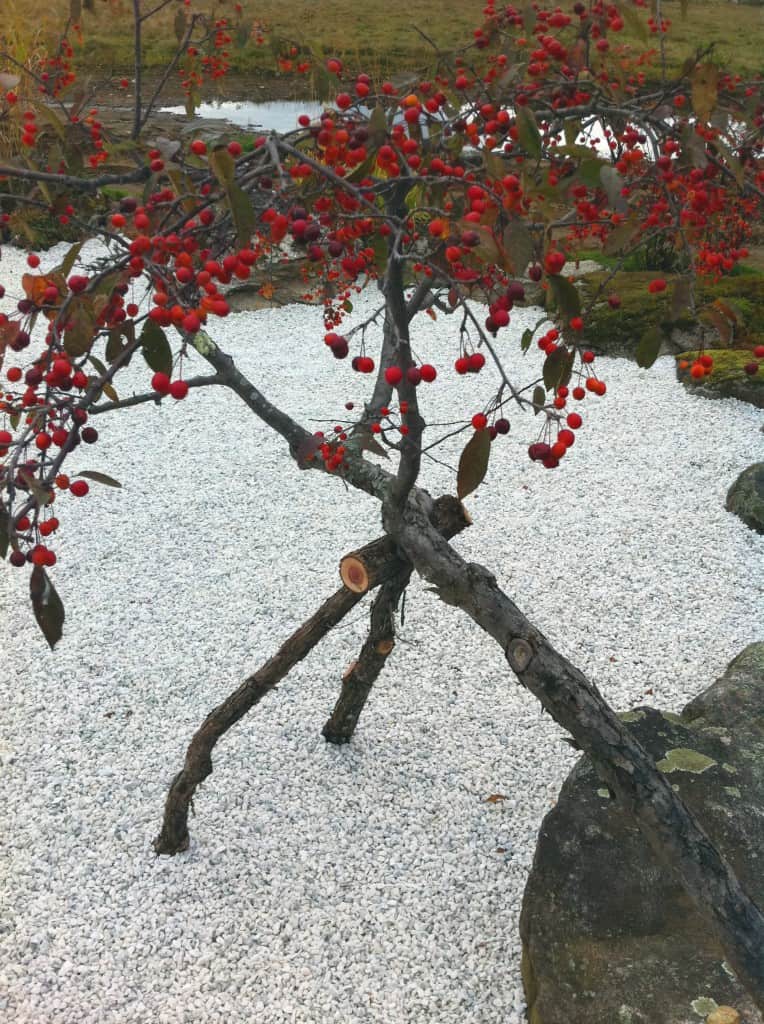
Striking red fruit against a pool of white gravel.
When Palmer returned, we drove to the nursery entrance on the other side of a cow pasture. Palmer’s story is similar to that of many who fall in love with Japanese gardens – love at first sight. He was riveted at an early age by the books his father, architect Carl Koelb, had on Japanese gardens. He knew when he was twelve years old that he loved the art and design found in this garden tradition.
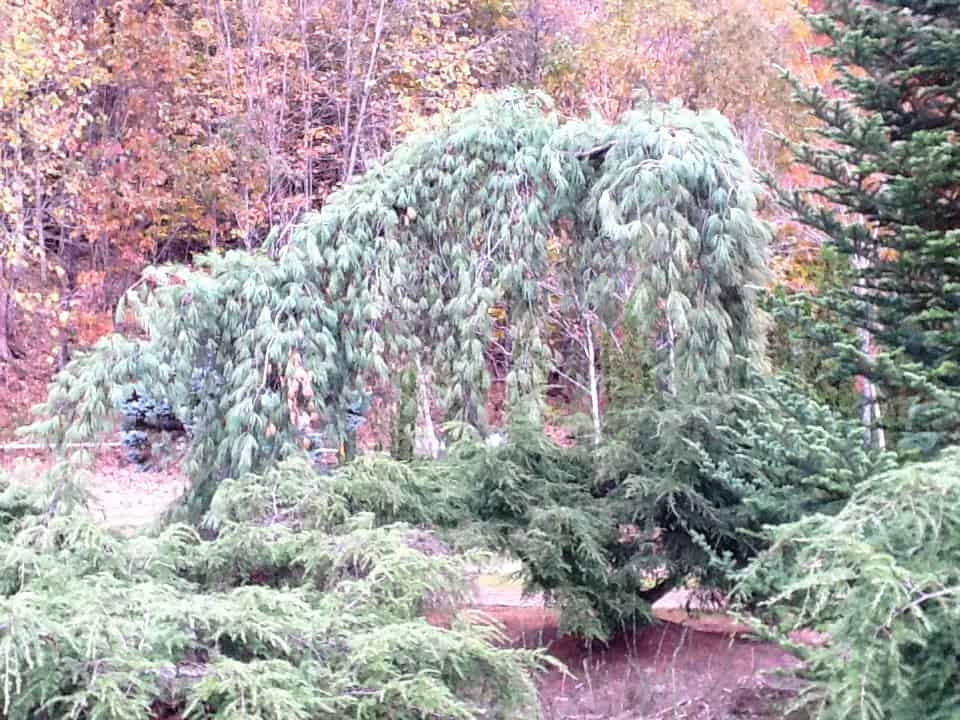 A weeping Eastern white pine (Pinus strobus ‘Pendula’) drapes its graceful branches behind Sargent’s weeping hemlocks (Tsuga canadensis ‘Pendula’). Photo: Julie Moir Messervy.
A weeping Eastern white pine (Pinus strobus ‘Pendula’) drapes its graceful branches behind Sargent’s weeping hemlocks (Tsuga canadensis ‘Pendula’). Photo: Julie Moir Messervy.
We walked among the plant varieties of Picea, Tsuga, Pinus, and more, and I noticed that each tree had its own unique character. Some trees were larger than I had seen in any nursery, some were pruned to display their unique personality or to play with the sense of scale, some trees invited you to laugh, be surprised…or even gasp.
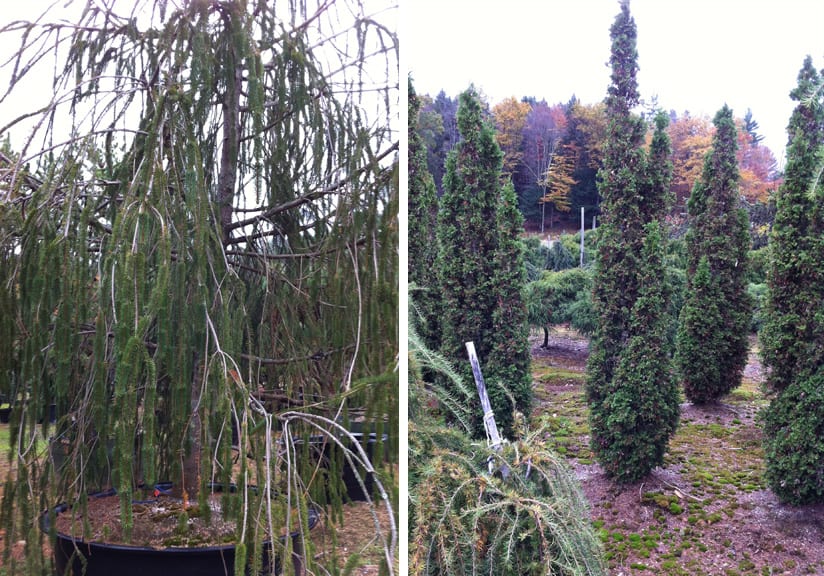
L: Picea abies ‘Virgata,’ or Norway snake spruce: striking and beautiful, but be warned, it’s not as soft as it looks. R: Thuja occidentalis ‘Degroot’s Spire,’ which Palmer describes as “the horticultural exclamation point.”
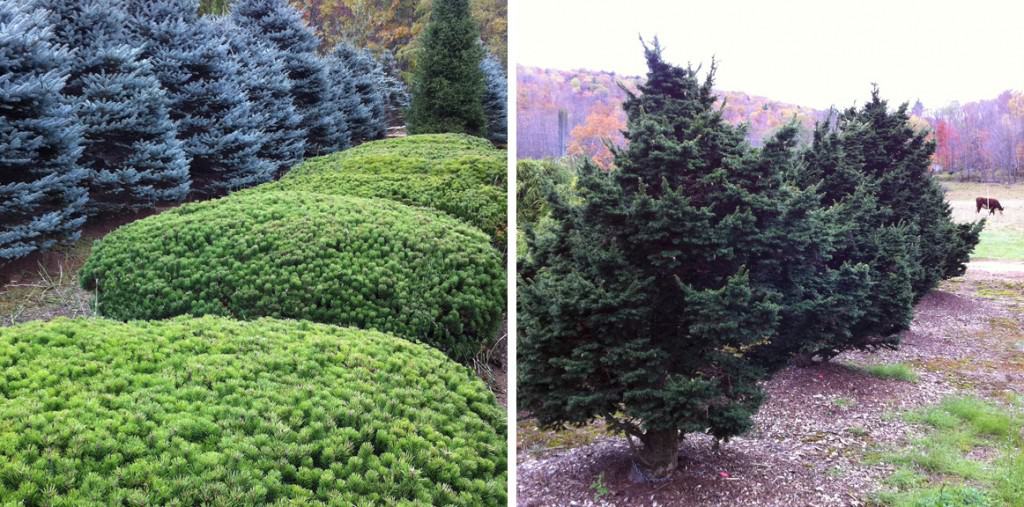
L: Pinus mugo subsp. mugo, a low, slow-growing, very cold-tolerant shrub. R: Hemlock Tsuga hussii, a rare variety that needs no pruning and has great depth and three-dimensionality.
Palmer’s connection to plants can be traced back to Weston Nurseries. As a neighbor to the nursery’s original site, Palmer was exposed to the variety of general nursery stock and some rare plants as well. He opened his own nursery and developed his interest in grafting. His collection—amassed over 40 years and now numbering over 100 different cultivars (mostly conifers)—is divided between his Shin-Boku Nursery and Baker Valley Nursery locations. Palmer, his wife Deb, and foreman Bill Balch care for hundreds of trees and shrubs, employing a long-standing tradition of Japanese-style pruning.
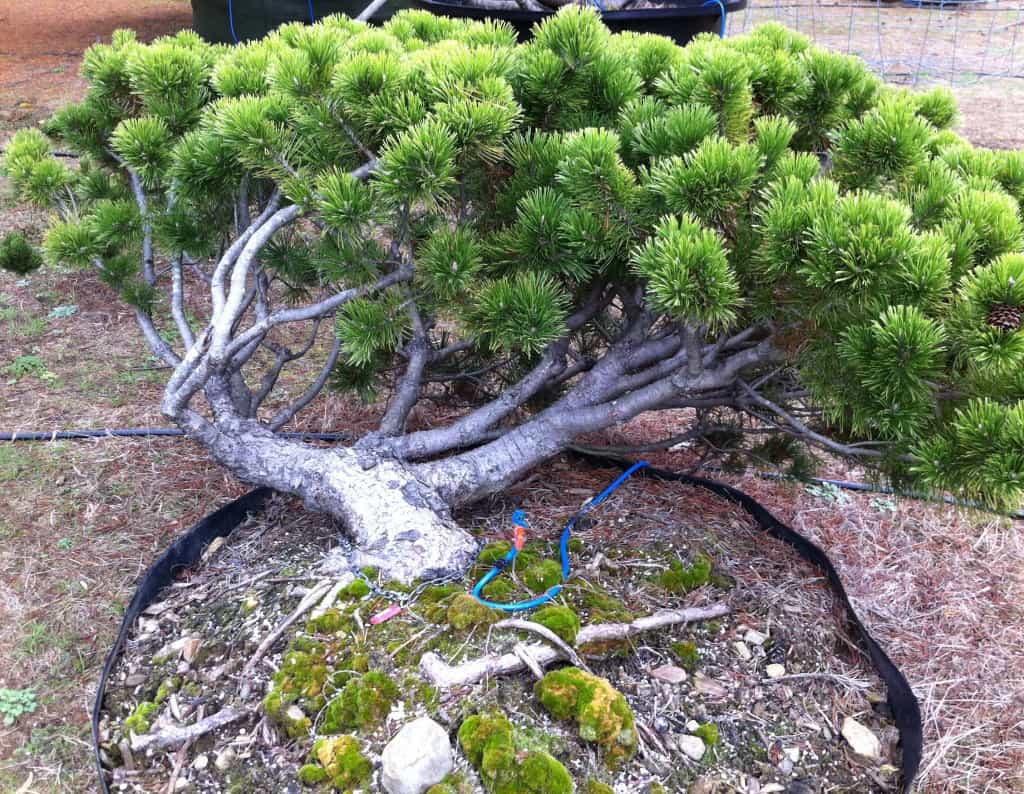
I liked this small Pinus telling its own story with a bed of moss at its feet.
We soon met Bill, who stopped for a moment to chat, though he had many items on his to do list: pruning, transplanting, and preparing trees for winter. He and Palmer are clearly a genuine team. Palmer said of Bill, “His experience and equipment talents are one-of-a-kind. I am very lucky to have him.”
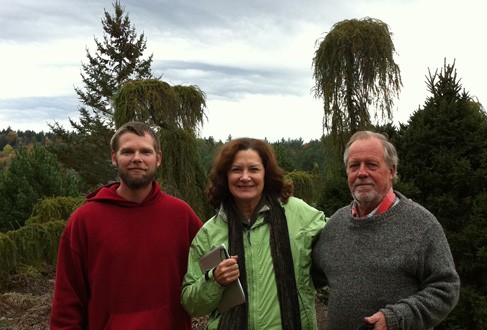
Shin-Boku’s foreman, Bill Balch, Julie Moir Messervy, and nursery owner Palmer Koelb.
After touring Shin-Boku, we traveled a few miles to Baker Valley Nursery, to walk among very impressive mature tree specimens. As we wove our way through the rows, we came across the sweet scent of the Katsura tree, Cercidiphyllum japonicum. Touched by the cold frost, it smelled like cotton candy. Neither Julie nor I had experienced it before, and we both agreed that children would be excited by this surprise –inspiration for a Children’s Garden! And then the two dancing larch trees – where can we use those? So many ideas!
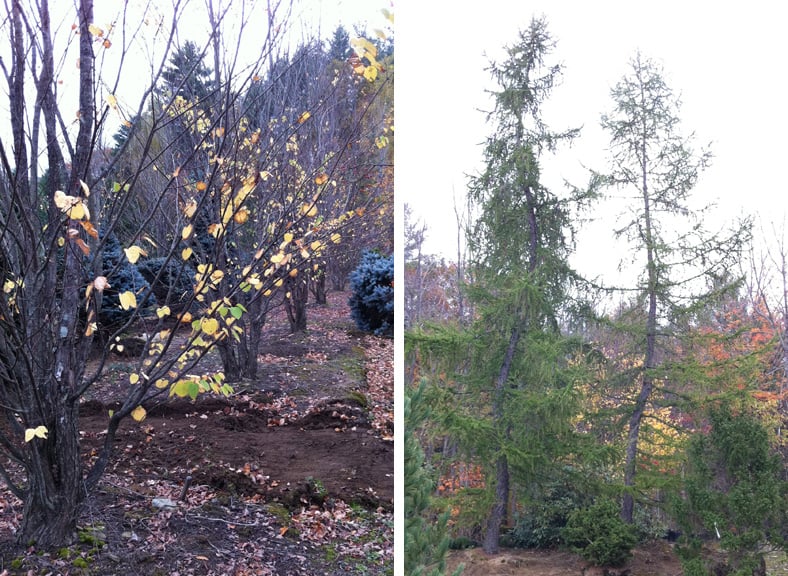
L: The Katsura tree (Cercidiphyllum japonicum), almost leafless, still broadcasts its cotton-candy fragrance. R: Two playful dancing larches (Larix decidua) resemble creations of Dr. Seuess.

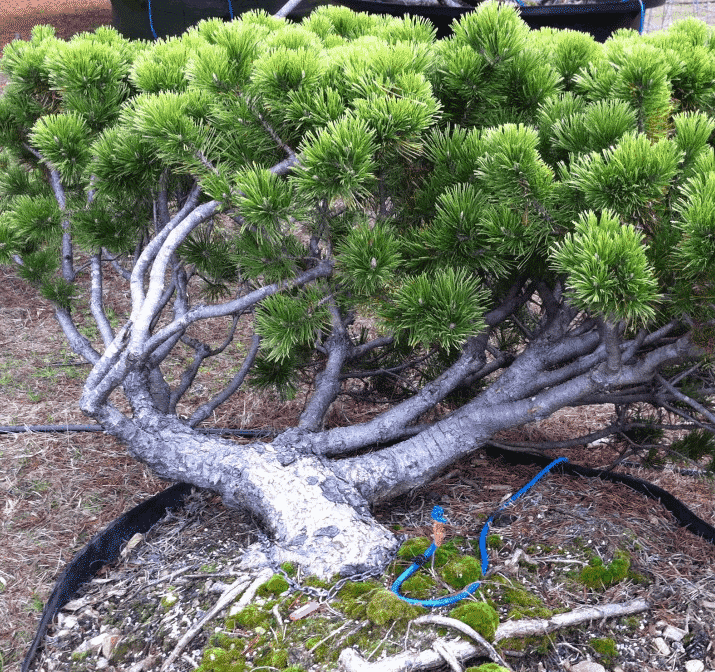





I loved this article and what great pictures! I felt like I was on the fieldtrip with you ladies. Thanks for the very intersting and informative stroll.
“interesting”, that is.
Jana and I had a wonderful day looking at so many exquisite specimen trees. I was glad to finally meet Palmer and to share in his enthusiasm for Japanese aesthetics as displayed throughout his nursery. I can’t wait to see some of these beauties moved into gardens that we have designed!
Julie, over the years i’ve noticed how Japanese design has inspired you, incorporating trees and rocks in your designs as you do. I can see why this visit was such a blessing for you. I don’t have the space for new trees but maybe i can experiment a little with rocks to add a little interest in my garden. OOOH if i study and ponder long enough i’ll bet ya i could find a way for a small tree someplace. Thanks for the tour- beautiful.
Jana –
Loved the article and the pictures. I am inspired by your presentation and, of course, by the garden and nursery. I may have to make the trip over there this spring, looking for the perfect Japanese Maple for the “slope”.
Thank you so much for this post, Julie and Jana! This beautiful nursery is going to the top of my “destination nurseries” list, and I have to experience a tree that smells like cotton candy!
It was a great honor to walk through the nursery and stroll Garden with Julie & Jana. Their observations were constructive and helpful. And…we had fun ! Thank you both for the visit.
Great article, thanks. Shin-boku looks like a great place to stroll through and see all of their specimen trees. I hope to make it up there sometime.